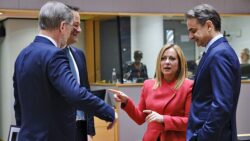After a summit in Brussels that ran into the wee hours, European Union leaders struck a hard-line tone on migration policy, threatening to use visa permits, trade flows and development aid as leverages to crack down on irregular border crossings and speed up the return of unsuccessful asylum-seekers.
In a small win for Italy, heads of state and government urged “reinforced cooperation” on search-and-rescue operations in the Central Mediterranean, a reference to the activities of private NGOs.
The hard-right government of Prime Minister Georgia Meloni has recently adopted a mandatory code of conduct for rescue ships and is pushing to have similar rules at the EU level, a move that has gained some traction but remains distant.
“We asked and obtained that the European Council’s conclusions be focused on the external dimension and therefore on the protection of the EU’s external borders, taking into account the difference that exists between (national) borders, and particularly the specificity of maritime borders,” Meloni told reporters on Friday, openly taking credit for the tough wording.
“All of this can be found in the conclusions.”
Safe countries of origin and returns
Meloni is seen as instrumental in having brought the divisive issue of migration back to the very top of the EU’s agenda after the bloc spent years immersed in the pandemic, the war and the energy crisis.
“Immigration is a European problem and requires a European response. In my view, this (recognition) considerably changes the approach to migration policy,” Meloni said.
Last year the EU registered 330,000 irregular border crossings and 924,000 asylum applications, an increase of 64% and 46% respectively compared to 2021.
Leaders have raised the alarm about an increase in asylum requests from nationals of countries traditionally considered “safe,” such as Turkey, Bangladesh, Morocco, Georgia, Egypt and Peru.
But the concept of “safe countries of origin” is widely contested by civil society and varies from country to country, creating fragmentation and a lack of predictability.
The summit’s conclusions called for a more “coordinated approach” in this regard, with a view to creating common EU lists of “safe third countries.”
The European Commission estimates that over 61% of the 924,000 asylum applications filed last year were made by people who are not in need of international protection.
In parallel, the bloc is struggling with a low return rate of ineligible asylum-seekers, estimated at 21%, something that has further fuelled calls for a more forceful diplomatic engagement.
“Swift action is needed to ensure effective returns,” the conclusions read, encouraging member states to recognise each other’s return decisions.
Leaders propose a “whole-of-government” model, involving EU institutions and national governments, to use “diplomacy, development, trade and visas,” as well as legal work opportunities, as leverages to compel other countries to take back rejected asylum-seekers.
The possibility of triggering Article 25a of the EU’s Visa Code, which can slap restrictive measures on uncooperative countries, is definitely on the table, leaders confirmed.
Fences and EU funds
The summit’s conclusions reflected the ongoing shift from the internal management of migration, which entails the politically explosive issue of relocation, towards external management, where political agreement has proven easier to find.
“Borders must be managed,” said European Commission President Ursula von der Leyen after the meeting came to an end. “We will act to strengthen our external borders and prevent irregular migration.”
However, the contentious idea of using EU funds to finance fences and barbed wires did not make it to the conclusions, highlighting the absence of consensus.
Asked about that very possibility, President von der Leyen once again said her executive was not in favour of bankrolling the infrastructure itself but was open to paying for equipment to strengthen surveillance, such as cameras, vehicles and watch-towers.
One of the pilot projects currently in place “has an existing fence but nothing else, so it doesn’t function,” von der Leyen said, referring to the wire fence along the Bulgaria-Turkish border.
“All these topics should be in an integrated package,” she went on.
“The focus is on having a functioning border that we know if somebody comes there’s a procedure that should be the same all over the European Union’s external borders.”
Austrian Chancellor Karl Nehammer, one of the most vocal advocates behind the idea of using EU funds to build fences, said after the meeting the bloc needed to “pull the brake” on illegal migration.
“We need the money for it, no matter if you call it a fence or border infrastructure,” the chancellor said.
Nehammer had previously asked Brussels for EUR2 billion in EU funds for Bulgaria to help it shore up the fence with Turkey, a request that has so far been rejected. Last December, Vienna invoked the rise in migration as grounds for blocking Sofia’s bid to join the passport-free Schengen area.
The European Commission says it only has EUR2.7 billion left to support migration and border management across all member states until the end of 2027, when the long-term budget ends.
Still, Nehammer welcomed the summit’s conclusions, calling them an “important signal.”
“There has never been a Council with such clarity,” he said.




